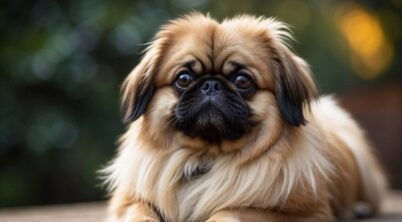Pekingese dogs, with their long, flowing coats and regal disposition, are a breed that dates back over a thousand years. Originating in China, they have been companions to royalty and commoners alike, making their mark as a beloved breed worldwide. Despite their charming appearance and affectionate nature, Pekingese can be prone to allergies, a common health issue that affects many dog breeds. These allergies can manifest through various symptoms and have triggers ranging from environmental factors to dietary sensitivities.
Allergic reactions in Pekingese can present in multiple ways, including skin rashes, itching, hot spots, and ear infections but may also extend to gastrointestinal upsets such as vomiting and diarrhea. With allergies sometimes being food-related, ingredients such as chicken, beef, dairy, wheat, and corn are identified as potential allergens for this breed. Beyond food, the Pekingese’s densely packed fur can trap pollen and other environmental allergens, leading to respiratory difficulties or skin conditions that prompt excessive scratching and discomfort.
Management of allergies in Pekingese involves a comprehensive approach, encompassing both preventative measures and treatments. Attention to diet, careful observation of environmental factors, and appropriate veterinary guidance are crucial in addressing the discomfort associated with allergic responses. Owners of Pekingese dogs need to be vigilant in identifying the signs of allergies early to provide their pets with relief from these common yet resolving issues.
Table of Contents
Understanding Pekingese Allergies
When discussing Pekingese allergies, it’s important to consider the common allergens specific to the breed and the symptoms they manifest. These elements are crucial for owners to recognize and manage allergies in their Pekingese dogs effectively.
Common Allergens in Pekingese Dogs
Allergens affecting Pekingese dogs can range from environmental factors to dietary irritants. Fur itself is not an allergen, but it can trap substances that cause allergic reactions.
- Environmental Allergens:
- Pollen: Trees, grasses, and weeds
- Dust Mites: Microscopic organisms found in household dust
- Mold Spores: Fungal growth in damp areas
- Other Potential Allergens:
- Food Ingredients: Common culprits include beef, chicken, dairy, and wheat.
- Fleas (Saliva): Contact with flea saliva can lead to allergic dermatitis.
- Chemical Irritants: Household cleaners and certain shampoos can provoke reactions.
The allergens can be inhaled or come into contact with the dog’s skin, leading to various symptoms.
Symptoms of Allergies in Pekingese
Pekingese dogs may exhibit a range of signs indicating an allergic reaction. Recognizing these can aid in timely intervention and treatment.
- Physical Signs:
- Skin Irritation: Itching, redness, and rashes
- Respiratory Issues: Sneezing and wheezing
- Visible Reactions:
- Watery Eyes: An indication of allergens affecting the eye area
- Ear Infections: Can result from ongoing allergic reactions
- Digestive Disturbances: May occur if food allergens are present
The presence of dander, which is flakes of dead skin, as well as saliva from the dog, can also trigger allergies in humans. These symptoms may be more pronounced during shedding season when Pekingese dogs lose more hair and dander. It’s imperative for owners to be aware that while these reactions can cause discomfort in their pets, effective management strategies exist to alleviate the symptoms.
Managing Allergy-Prone Pekingese
For Pekingese owners, managing allergies involves regular grooming and controlling the environment to minimize exposure to allergens. These strategies help alleviate symptoms for both the dogs and their human companions.
Grooming Practices to Reduce Allergic Reactions
Brushing: Regular brushing is essential to manage shedding, as Pekingese dogs have long, thick fur that is prone to matting and can trap dust and pollen. Brushing several times a week helps to remove loose fur and reduce the amount of hair and dander in the environment.
- Frequency: Ideally, brushing should be done every 2-3 days.
- Tools: Use a bristle brush or a de-shedding tool appropriate for the Pekingese’s coat.
Bathing: Bathing the Pekingese can help remove accumulated allergens from the fur. However, it is important not to over-bathe, as this can lead to dry skin and increase itching and dander production.
- Suggested Routine: Bathe every 4-6 weeks using a mild, hypoallergenic shampoo.
- Post-Bath Care: Always dry the coat thoroughly to prevent skin infections.
Environmental Management for Allergens
Vacuuming: Regular vacuuming of the home reduces the presence of allergens like dust, dander, and pollen. Owners should focus on areas where the Pekingese spends the most time.
- Recommendation: Vacuum at least twice a week with a HEPA filter-equipped vacuum cleaner.
Air Purifiers: Air purifiers can help to remove allergens from the air inside the home, providing relief for both the Pekingese and allergic individuals.
- Placement: Position air purifiers in rooms frequented by the Pekingese, such as the living room and bedroom.
Additional Measures:
- Omega-3 Supplements: Introducing Omega-3 into the Pekingese’s diet can help combat inflammation associated with allergies.
- Environment: Keep the living space free of perfumes, scented candles, and other potential airborne irritants that can exacerbate the Pekingese’s allergies.
Comparing Pekingese to Hypoallergenic Breeds

This section examines the characteristics of Pekingese dogs in the context of hypoallergenic breeds, shedding light on considerations for allergy sufferers.
Traits of Hypoallergenic Dogs
Hypoallergenic dog breeds are those that are less likely to cause allergic reactions in sensitive individuals. These breeds typically produce fewer allergenic proteins in their dander, saliva, and urine and often shed less than other breeds. Key features of hypoallergenic dogs include minimal shedding, a tendency to produce fewer allergenic proteins, and the need for regular grooming to maintain a clean coat that collects less allergens.
Common hypoallergenic breeds include:
- Poodle: Known for its curly, low-shedding coat.
- Bichon Frise: Features a fluffy, low-shedding coat that requires regular grooming.
- Yorkshire Terrier (Yorkie): Has fine, human-like hair that sheds minimally.
- Shih Tzu: Although it has long hair, it sheds less compared to other breeds.
- Portuguese Water Dog: Sports a water-resistant coat that’s also dander-resistant.
Pekingese vs. Hypoallergenic Breeds
The Pekingese Breed is not considered hypoallergenic due to its propensity to shed significantly. Unlike hypoallergenic dogs such as Poodles and Bichon Frises, which have hair that grows continuously while shedding minimally, the Pekingese has a double coat that can contribute to increased levels of dander and airborne allergens.
Here is how Pekingese compare to a few hypoallergenic counterparts:
| Breed | Shedding | Allergenic Proteins | Grooming Needs |
|---|---|---|---|
| Pekingese | High | Higher production | High |
| Poodle | Minimal | Lower production | High |
| Bichon Frise | Minimal | Lower production | High |
| Yorkshire Terrier | Minimal | Lower production | Moderate to High |
| Shih Tzu | Minimal | Lower production | High |
It is important for individuals with allergies to consider these differences, as the Pekingese breed can exacerbate health problems for those sensitive to dog dander and hair. In contrast, hypoallergenic breeds may pose fewer challenges to allergy sufferers, though it is essential to note that no breed is entirely free of allergens. Regular grooming and cleanliness can help manage allergens for all dog breeds.
Diet and Nutritional Support for Allergy Management
When managing allergies in Pekingese, dietary adjustments can be a central component of the canine’s overall health strategy. Allergies may manifest through gastrointestinal symptoms like vomiting or diarrhea, or through skin-related symptoms such as itching. Identifying and eliminating food allergies is a pivotal step.
A balanced diet is essential. Ingredients known to support the immune system include:
- Vitamins A, D, E, and B-complex: vital for immune health
- Minerals such as calcium and phosphorus: promote bone strength
For dogs with food allergies, hypoallergenic diets that avoid common allergens—such as beef, dairy, or wheat—may alleviate symptoms. It’s advisable to introduce novel protein sources that the dog has not been exposed to before.
In addition to main meals, supplements can offer support:
- Probiotics: aid in maintaining healthy gut flora, crucial for a strong immune system
- Fatty acids (like omega-3 and omega-6): help reduce inflammatory responses associated with allergies
Furthermore, dogs may benefit from specialized diets, like those with limited ingredients to minimize exposure to potential allergens. Always consult with a veterinarian before transitioning to a new diet to ensure it fits the specific needs of the Pekingese. Here’s a potential feeding plan:
| Meal Type | Consideration |
|---|---|
| Main Diet | Limited ingredient or novel protein source |
| Supplements | Probiotics, omega fatty acids |
| Feeding Practice | Portion control to manage weight and prevent additional health issues |
Selecting the right food and supplements can greatly enhance a Pekingese’s ability to manage allergies effectively and maintain a quality life.
Living with a Pekingese: Tips and Considerations

When considering adding a Pekingese to one’s life, it’s important to understand the breed’s characteristics and how to manage allergies. This section provides practical advice on selecting a Pekingese from a reputable breeder and lifestyle adjustments for individuals with allergies.
Selecting a Pekingese from a Breeder
Choosing a Pekingese from a breeder should be approached with diligence. Reputable breeders will prioritize the health and temperament of the breed. Prospective owners should seek breeders who can provide thorough health clearances for both parents of the puppy. This ensures that the Pekingese is, to the best of the breeder’s knowledge, free from genetic conditions that may exacerbate allergies, such as chronic skin problems.
- Breeder Research: Investigate breeders thoroughly, ensuring they adhere to ethical breeding practices.
- Parental Health: Request health clearances of the puppy’s parents to minimize potential allergenic conditions.
- Puppy Interaction: Spend time with the Pekingese puppies to gauge individual allergic reactions before making a decision.
Lifestyle Adjustments for Allergic Owners
For owners who are sensitive to allergenic dander, adjustments within the home are critical to cohabitating with a Pekingese. These dogs are known to shed, and although no dog is truly hypoallergenic, regular grooming and cleanliness can help manage dander levels.
- Daily Grooming: Frequent brushing of the Pekingese’s coat can reduce the amount of loose fur and dander.
- Housekeeping: Maintaining a clean house, with regular vacuuming and dusting, is essential.
- Designated Areas: Keep the Pekingese out of certain areas, such as bedrooms, to create dander-free zones.
- HEPA Filters: Use HEPA air filters to help capture airborne allergens.
By being cognizant of the Pekingese’s dignified and independent nature, owners can also tailor their exercise and companionship to be in line with the breed’s needs, which includes moderate exercise suitable for apartment living. Despite their regal appearance, Pekingese dogs are also effective watchdogs, due to their loyal disposition. In dealing with housebreaking, it is beneficial to understand that the breed may require consistent training due to their independent streak.
Prospective owners should be prepared for a decisive approach to training and integrating these adjustments, especially when sensitive individuals are involved. This will create an environment that honors the Pekingese’s character while safeguarding the owner’s health.








